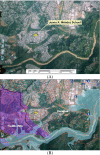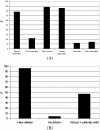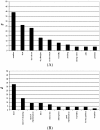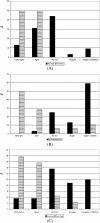Risk assessment and community participation model for environmental asthma management in an elementary public school: a case study in Puerto Rico
- PMID: 16823079
- PMCID: PMC3785682
- DOI: 10.3390/ijerph2006030009
Risk assessment and community participation model for environmental asthma management in an elementary public school: a case study in Puerto Rico
Abstract
Asthma is a rapidly growing chronic disease in the general population of the world, mostly in children. Puerto Ricans have the highest prevalence of children with asthma among the Hispanic community in the US and its territories. Asthma and air quality are becoming a significant and potentially costly public health issue in Puerto Rico. The CDC has reported that in Puerto Rico, 320,350 adults have asthma and this number represents 11.5% of the island adult population. The north east municipality of Carolina, Puerto Rico, has the highest asthma prevalence in the 0 to 17 year old range (2001 data). In this study, we address the potential relationship between anthropogenic and naturally occurring environmental factors, and asthma prevalence in an urban elementary public school in Carolina in an effort to empower and engage communities to work on their environmental health issues. We integrated geographic information systems (GIS) data of anthropogenic activities near the school as well as the natural resources and geomorphology of the region. We found that as Carolina is close by to Caribbean National Forest (El Yunque), this together with the temperature and precipitation cycles in the zone creates the ideal environmental conditions for increased humidity and pollen, mold and fungi development through out the year. We also collected health and socio economic data to generate an asthma profile of the students, employees and parents from the school community, and through a survey we identified perceptions on environmental asthma triggers, and indoor air quality in the school and homes of the students and employees. Finally, we implemented a workshop on indoor air quality designed to engage the school community in managing asthma triggers and the school environment. Our results showed that nearly 30 % of its student's population has asthma, and from this group 58% are males and 42% are female students. Of all asthmatic children, only 43% receive treatment for the disease. The study also showed that most asthmatic children are between 7 and 9 year old, and live in households with an annual income below 10,000 dollars. It also showed that 25 % of the student's parents have the condition, and that 25% of the employees are also affected by this chronic condition. All these numbers are significantly higher than those reported by the CDC for Puerto Rico. The perception component had a response of 83% of school employees, and a 39% response from parents. It showed that people know asthma as a disease but many can't identify most environmental asthma triggers. Pre and post tests of the workshop protocol showed that before the activity only 21% of participants can identify asthma triggers. At the end of the workshop nearly 80% were able to identify and manage environmental asthma triggers. This work validates the fact that Puerto Rico continues to have a significant number of people with asthma, particularly children asthma, and that schools are an important settings to create community based action plans to manage environmental asthma triggers through outreach and training.
Figures









Similar articles
-
The effectiveness of school-based family asthma educational programs on the quality of life and number of asthma exacerbations of children aged five to 18 years diagnosed with asthma: a systematic review protocol.JBI Database System Rev Implement Rep. 2015 Oct;13(10):69-81. doi: 10.11124/jbisrir-2015-2335. JBI Database System Rev Implement Rep. 2015. PMID: 26571284
-
Elevated asthma and indoor environmental exposures among Puerto Rican children of East Harlem.J Asthma. 2003;40(5):557-69. doi: 10.1081/jas-120019028. J Asthma. 2003. PMID: 14529106
-
Uncontrolled asthma and household environmental exposures in Puerto Rico.J Asthma. 2022 Mar;59(3):427-433. doi: 10.1080/02770903.2020.1858861. Epub 2020 Dec 21. J Asthma. 2022. PMID: 33272056 Free PMC article.
-
School-based self-management interventions for asthma in children and adolescents: a mixed methods systematic review.Cochrane Database Syst Rev. 2019 Jan 28;1(1):CD011651. doi: 10.1002/14651858.CD011651.pub2. Cochrane Database Syst Rev. 2019. PMID: 30687940 Free PMC article.
-
Compound Crises: The Impact of Emergencies and Disasters on Mental Health Services in Puerto Rico.Int J Environ Res Public Health. 2024 Sep 25;21(10):1273. doi: 10.3390/ijerph21101273. Int J Environ Res Public Health. 2024. PMID: 39457247 Free PMC article. Review.
Cited by
-
Sensitization to airborne ascospores, basidiospores, and fungal fragments in allergic rhinitis and asthmatic subjects in San Juan, Puerto Rico.Int Arch Allergy Immunol. 2011;155(4):322-34. doi: 10.1159/000321610. Epub 2011 Feb 22. Int Arch Allergy Immunol. 2011. PMID: 21346362 Free PMC article.
References
-
- Masoli M, Fabian D, Holt S, Beasley R. Global Burden for Asthma. Medical Research Institute of New Zealand. Developed for the Global Initiative for Asthma. Wellington, New Zealand. University of Southampton; Southampton, UK: 2004. pp. 1–13.
-
- American Lung Association (ALA) Trends in asthma morbidity and mortality [Online] May 15, 2001. http://www.lngusa.org/pub/minority/mldd
-
- Centers for Disease Control and Prevention (CDC) 1999. 1999. CDC’s Asthma Prevention Program of the National Center for Environmental Health, CDC, At-A-Glance, [Online]. Available: http://www.cdc.gov/nceh/asthma/ataglance/asthmaag2.htm.
-
- Meurer JR, McKenzei S, Mischler E, Subichin S. The Awesome Asthma School Days program: Educating children, inspiring a community. The Journal of School Health. 1999;69(2):63–68. - PubMed
-
- Beckett WS, Belanger K, Gent JF, Holford TR, Leaderer BP. Asthma among Puerto Rican Hispanics: a multi-ethnic comparison study of risk factors. American Journal of Respiratory Critical Medicine. 1996;154(4Pt1):894–9. - PubMed
Publication types
MeSH terms
LinkOut - more resources
Full Text Sources
Medical
